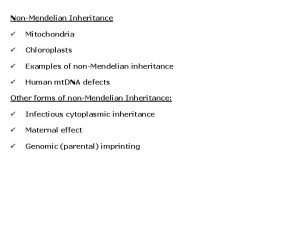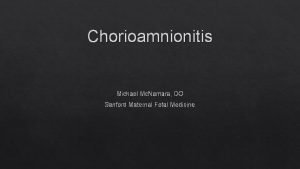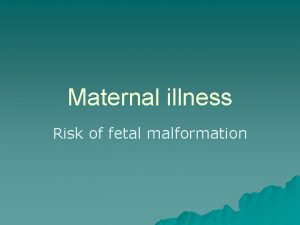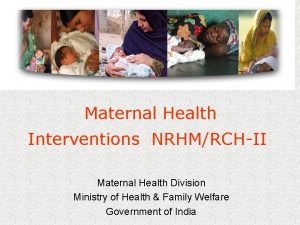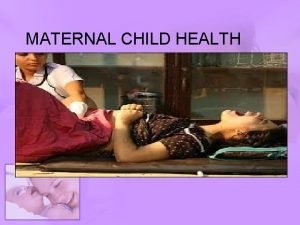Implementing Quality An introduction to Quality Standards Maternal












- Slides: 12

Implementing Quality: An introduction to Quality Standards Maternal Quality Standards in the South African context Workshop, Pretoria , 6 April 2016 Dr Françoise Cluzeau, Associate Director NICE International

What are Quality Standards? Quality standards are a concise set of evidence-informed statements, designed to drive and measure priority quality improvements, within a particular area of care (e. g. management third stage labour)

Quality Standards aim to improve quality and reduce variation 1. Markers of high quality care (maximise impact in terms of: clinical effectiveness, safety, equity and raising overall quality). not minimum standards! 2. Focus on areas where sub-optimal clinical practice is common 3. Derived from best available evidence, e. g. WHO, other local guidance 4. Aligned with government/payer priorities 5. Produced collaboratively with stakeholders (policymakers, payers, hospital managers, clinicians (inc. nurses, health workers), service users professional/patient organisations) 6. And through a transparent process

The linking process • Medical education and professional training • Performance management • Budget management Clinical Trials and Evidence Reviews Clinical Guidelines Clinical Pathways of Care and Quality Standards • Provider payment mechanisms incl. casebased payment • Communication to patients and their families • Clinical audit & provider benchmarking • Provider regulation and accreditation Copyright © 2010 - 2011 NICE

Quality statement developed from international and local guidance Management of third stage of labour* WHO recommendations Quality statement Women who have given birth either vaginally or by caesarean are offered a bolus dose of oxytocin or ergometrine at the time of delivery of the shoulder or within 1 minute of the delivery of foetus to prevent post partum haemorrhage and to assist delivery of the placenta Oxytocin (10 IU, IV/IM) is the recommended uterotonic drug for the prevention of post partum haemorrhage. (Strong recommendation, moderate-quality evidence) KOFG recommendations Administer uterotonic agent within 1 min. of delivery of baby. (Oxytocin or syntometrine or ergometrine) *Third stage of labour: From delivery of the fetus to the complete delivery of the placenta

Quality measure Measures of process Quality measure Proportion of women giving birth vaginally who receive oxytocin or ergometrine during third stage of labour = No. of women giving birth vaginally receiving oxytocin or ergometrine during third stage of labour in the hospital (numerator) All women giving birth vaginally in the hospital (denominator) Implementation Outcome Proportion of women who experience estimated blood loss ≥ 500 ml following a vaginal delivery

QS impacts on different audiences Service providers (maternal hospitals) • Ensure adequate human resources, equipment, drugs and supplies to provide 24 X 7 services Healthcare • Ensure training and adherence to professionals (obstetricians, nurses and standard protocols midwives) Payers (government, • Assurance of a standard quality of insurers, women giving care birth who pay for service)

Implementation From the implementation Plan in Kerala

Why evidence-informed quality standards for LMICs committing to Universal Health Coverage? • Aligned with accountability for reasonableness principles (Daniels, 2000) • Can be developed relatively quickly, are locally relevant • Provide clear priorities for quality improvement • Describe what needs to be in place for best practice, thus “closer to implementation” • Provide key performance indicators that can be readily linked to audit, payment, accreditation, education However: • Requires some assumptions about relevance of source guidelines (e. g. cost-effectiveness? ), and contextualisation Campbell, S. M. , Godman, B. , Diogene, E. , Furst, J. , Gustafsson, L. L. , Mac. Bride-Stewart, S. , Malmstrom, R. E. , Pedersen, H. , Selke, G. , Vlahovic-Palcevski, V. , van, W. M. , Wong-Rieger, D. , & Wettermark, B. 2015, "Quality indicators as a tool in improving the introduction of new medicines", Basic Clin Pharmacol Toxicol. , vol. 116, no. 2, pp. 146 -157. 9

QS principles are relevant to all countries and health systems • Scientific evidence is international (starting point)even if decisions are locally made • Local stakeholders (QS Committee!) need to consider: o What are the local priorities for improvement? o What QS would have the most impact in the local context? o How can local health system structures and processes (including incentives) and resources drive implementation of QS? 10

Successful implementation of QS requires combination of driving forces Robust sources • Evidence-based clinical guidelines • Up-to-date survey of baseline activity and outcomes Information systems • Data collection • Regulatory mechanisms 11 Implementation strategy • Quality measures • Education, training and awareness raising • Financial and nonfinancial incentives Political support • Sustained funding • Inclusive institutions • Political will

Learning from other countries • Experience with the QS for maternal care in Kerala (Dr Paily ) • Experience from Vietnam (in stroke care) Case country examples contained in “Principles for developing Quality Standards in low & Middle Income countries” http: //www. idsihealth. org/knowledge_base/principlesfor-developing-clinical-quality-standards-in-lmics/
 Maternal effect and maternal inheritance
Maternal effect and maternal inheritance Maternal effect and maternal inheritance
Maternal effect and maternal inheritance Lochia alba smell
Lochia alba smell Plasenta bilobata
Plasenta bilobata Sex linked vs autosomal pedigree
Sex linked vs autosomal pedigree Cmqcc maternal data center
Cmqcc maternal data center Causes polyhydramnios
Causes polyhydramnios National health program related to child health
National health program related to child health Metaphase plate
Metaphase plate History of maternal and child health
History of maternal and child health Factors influencing maternal health
Factors influencing maternal health Sanford maternal fetal medicine
Sanford maternal fetal medicine Amniotic fluid color abnormalities
Amniotic fluid color abnormalities
